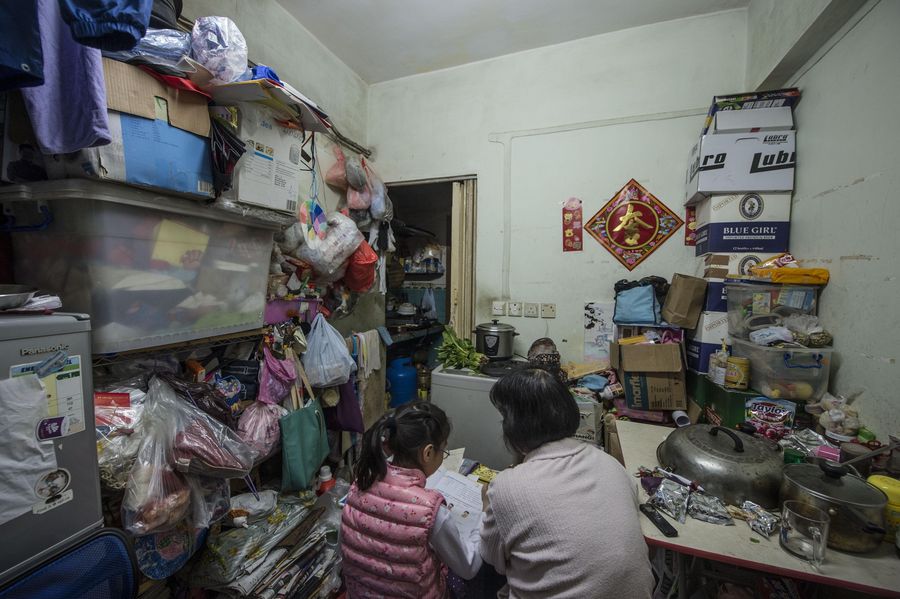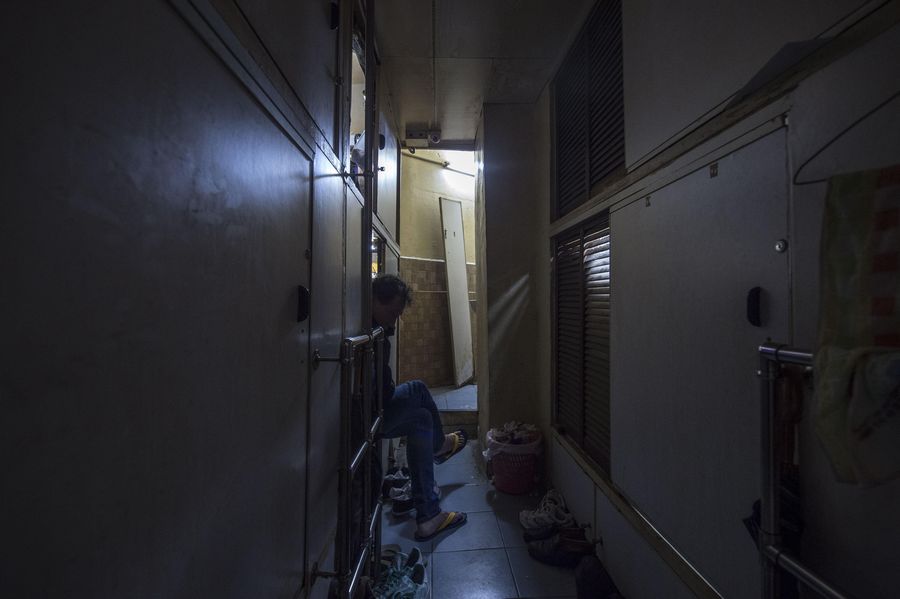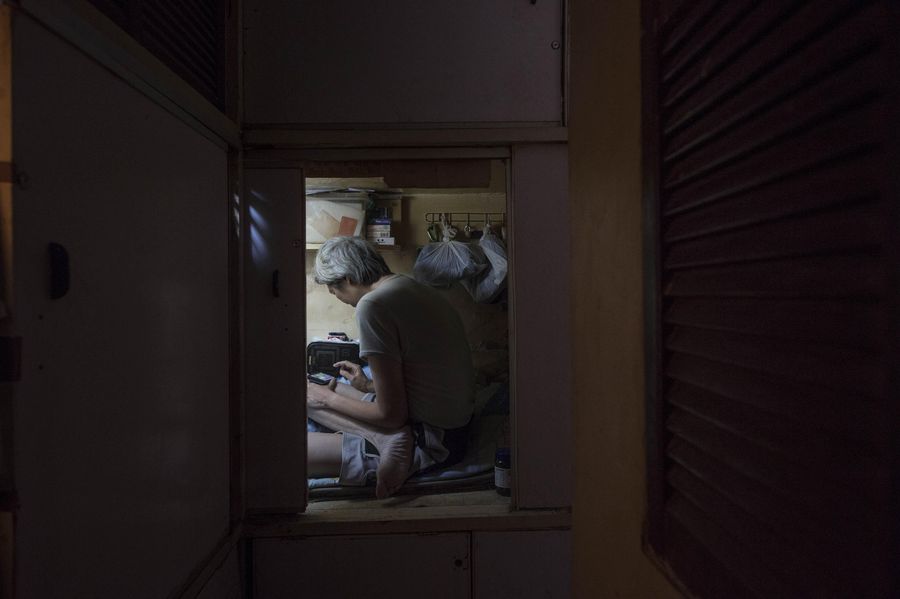
A woman tutors her daughter at a rented subdivided unit covering 20 square meters in Sham Shui Po, south China's Hong Kong, Jan. 19, 2016. (Xinhua)
The prolonged disturbances in Hong Kong, stemming from two proposed ordinance amendments concerning fugitive offenders, have reflected some deep-rooted conflicts and problems in Hong Kong society.
by Xinhua writers Fei Liena, Yi Ling, Liu Huan
HONG KONG, Sept. 10 (Xinhua) -- For over a month, Ah Po has been busily looking for a new "home," as her current rented subdivided unit will be sold by the owner at the end of September.
Working as a cleaner in Hong Kong, the 68-year-old earns a monthly salary of 9,500 HK dollars (about 1,200 U.S. dollars). To make a better living, she also distributes advertisement leaflets outside metro stations three or four times a week, earning a daily rate of 135 HK dollars.
The unit in which she lives is merely 10 square meters, but costs her 3,500 HK dollars a month.
Even with the high rent, it is hard for Ah Po to give up this place where she has lived for almost 10 years. "If I move to a new one, space may be even smaller, but the rent will be over 5,000 HK dollars," she said.

A 54-year-old man has a phone call at a rented subdivided unit covering 1.8 square meters in south China's Hong Kong, Jan. 14, 2016. (Xinhua)
UNAFFORDABLE HOUSING
A ubiquitous type of rental housing in Hong Kong, subdivided units come from dividing flats into more separate units than originally designed to house more people, usually low-income groups, with lower rents.
According to the data from the Census and Statistics Department of the Hong Kong Special Administrative Region (HKSAR) government in January 2018, Hong Kong had about 92,700 subdivided units with 209,700 people living in them.
The per capita living space of those people was 5.3 square meters.
Most subdivided units are found in old tenement buildings, the majority of which are located in Hong Kong's poorest district, Sham Shui Po, where Ah Po lives.
Frank, 28, works at a cosmetics store in Tsim Sha Tsui. He works long hours every day but only earns a bit over 20,000 HK dollars a month, barely covering his daily expenditure.
"I'd love to live on my own, but I can't afford the rent, so I'm still living with my parents right now," he said. As for buying an apartment in Hong Kong, that is beyond Frank's consideration.
Although prices differ depending on the location and condition, apartments in Hong Kong sells at over 147,000 HK dollars per square meter in 2019, according to real estate website squarefoot.com.hk.
In comparison, the median list price in New York is about 7,650 U.S. dollars (about 60,000 HK dollars) per square meter in 2019, said Norada Real Estate Investments.
The average sales price of apartments in Tokyo is 8,497 U.S. dollars (about 66,600 HK dollars) per square meter this year, according to realestate.co.jp.
To Frank, it seems that no matter how hard he works, there is no way for him to improve his living condition, let alone buying his own apartment.
"One won't have his peace of mind when he has no piece of land," said Frank. "Some young people in Hong Kong see no hope ahead, thus discontent emerges."
The prolonged disturbances in Hong Kong, stemming from two proposed ordinance amendments concerning fugitive offenders, have reflected some deep-rooted conflicts and problems in Hong Kong society.
A pressing problem is the living status of low-income people, said Lau Juen-yee, an economics professor at the Chinese University of Hong Kong.
Hong Kong's living cost is one of the highest in the world, with a large population still squeezing in pigeonholes, or tiny, unsafe subdivided units, which is unreasonable, said Lau.
Lee Wai-king, a chairperson of the Democratic Alliance for the Betterment and Progress of Hong Kong (DAB), said, "We must be determined to solve the deep-seated problems, otherwise social discontent will burst again."

A 52-year-old man plays a mobile game at a rented subdivided unit covering 1.8 square meters in south China's Hong Kong, Jan. 14, 2016. (Xinhua)
LAND SUPPLY SHORTAGE
If a house is bread, then the land is flour. An essential solution is to increase land supply.
How much land is Hong Kong lacking? According to the "Hong Kong 2030+" issued by the HKSAR Planning Department, the new land demand in the long term would be a minimum of about 4,800 hectares. Deducting a supply of about 3,600 hectares from the committed and planned projects, there is still a shortage of some 1,200 hectares.
According to the estimates of the Our Hong Kong Foundation, a Hong Kong-based think tank, combining elements such as population growth, Hong Kong needs 9,000 hectares of land for its long-term development.
With a total area of 1,107 square km, Hong Kong has only developed about 24 percent of the land, while 62 percent of the land has been "locked" by law from being developed. As a response, the HKSAR government has to squeeze land from the remaining 14 percent or reclaim land from the sea.
Experts observe that the HKSAR government often encounters interference and obstructions from the opposition and vested interest holders regarding government land expropriation or island-building plans.
For political purposes, the opposition has hyped the plight of "soaring property prices" and "people's destitution" on one hand and applied various reasons and excuses to prevent land development on the other hand.
Some vested interest groups, once noticing that their own interests are at stake, have put pressures on the government through various means, including taking legal actions.
Wong Yuen-shan, a deputy executive director of the Our Hong Kong Foundation, said that a land-related initiative can always be taken by the opposition as an opportunity for political mobilization to bolster their political energy.
In recent years, concerning the case of the relocation for Hong Kong's first-ever high-speed railway or the development of the Northeast New Territories, the opposition has repeatedly played the role of organizer and instigator for obstruction.
The HKSAR government's plans to develop the areas around country parks and reclaim land from the sea have also come under attack from the opposition, citing environmental concerns.
"They play both the angel and the devil," said Chan Yung, a deputy to the National People's Congress and vice chairperson of the DAB, adding that the opposition has kept making trouble while blaming the government for achieving nothing.
LAND RECLAMATION FROM SEA
In the long run, land reclamation from the sea is the best option for Hong Kong to develop land and solve the housing problem, experts say.
Land reclamation has always been inseparable from the development of Hong Kong. Six major new towns in Hong Kong are mostly built on reclaimed land after going through legal procedures and meeting environmental requirements.
A study by the Our Hong Kong Foundation shows that Hong Kong has reclaimed 7,000 hectares of land, housing 27 percent of its population and 70 percent of its office building spaces.
The advantages of increasing land supply by reclamation are obvious -- a large amount of leveled land can be obtained, with which the government can improve its plans with adequate infrastructure facilities.
It may also force some property developers, who hope to make huge profits by hoarding land, to reduce land storage and thus increase land and housing supplies to the property market.
"Once the supply of land increases, people's expectations will change," said Professor Lau, adding that land and housing prices will gradually become stable.
In that case, developers who hoard large amounts of land will have to speed up building and selling flats, he added.
HKSAR Chief Executive Carrie Lam proposed in her 2018 policy address the "Lantau Tomorrow Vision" -- a development project which includes the creation of a new business district on man-made islands in waters off Lantau Island.
The plan is to build 1,700 hectares of artificial islands in 20 to 30 years, with 260,000 to 400,000 flats to be built on these islands, offering housing to 700,000 to 1.1 million people.
According to the vision, 70 percent of the flats will be allocated for public housing with low rent to increase supply to the property market.
As good as it sounds, many Hong Kong people have expressed concerns on the implementation of the plan due to the recent chaos.
"My biggest wish is to live in a public flat, and I hope the 'tomorrow' is not too far away," said Ah Po.
As for Frank, he hopes the real estate market will cool down a bit so that he could see some hope for buying his own apartment. (Zhang Huan and Su Xiao also contributed to the story.)



